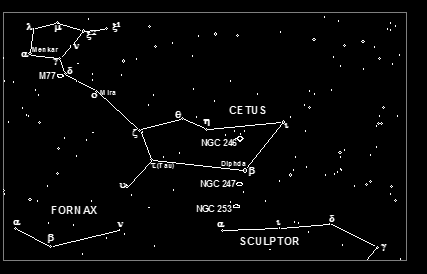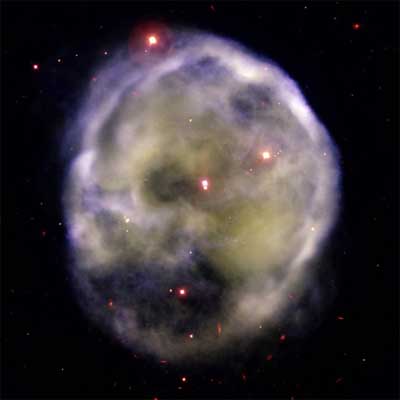Cetus, Sculptor and Fornax
Cetus is one of the rather faint constellations of autumn, and yet it is ancient, being included in the original 48 of Ptolemy’s Almagest. Its brightest star is second magnitude Diphda (Beta) but its most famous is undoubtedly the long period variable, Mira. This name, meaning “wonderful” was given to it by Hevelius in 1662 although Mira was actually discovered by the Dutch astronomer David Fabricius in 1596. Fabricius thought he had discovered a nova but Mira is in fact a red giant star whose brightness varies between about third and ninth magnitudes over a period of around 332 days. It has occasionally attained second magnitude and the period is also subject to considerable variability. The next maximum is due in February 2007 and since maxima occur about a month earlier each year they will become increasingly easy to observe over the next few years. Many more examples of long period variable stars with similar characteristics to that of Mira have subsequently been discovered, but Mira remains the most famous.
Fabricius thought he had discovered a nova but Mira is in fact a red giant star whose brightness varies between about third and ninth magnitudes over a period of around 332 days. It has occasionally attained second magnitude and the period is also subject to considerable variability. The next maximum is due in February 2007 and since maxima occur about a month earlier each year they will become increasingly easy to observe over the next few years. Many more examples of long period variable stars with similar characteristics to that of Mira have subsequently been discovered, but Mira remains the most famous.Another famous star in Cetus is Tau Ceti. This type G star is very similar to our own Sun and lies only 12 light years distant from us. It was therefore an early target for the “SETI” initiatives to attempt to detect radio signals from extra-terrestrial civilizations. Recent observations of the star suggest however that it has ten times as much material orbiting it in the form of comets and asteroids as does our Sun and therefore may not be a suitable place for life-bearing planets after all.

Skull Nebula NGC246 (Gemini South image)
Cetus possesses just one object from the Messier catalogue. This is the tenth magnitude galaxy, M77. As well as being one of the first galaxies discovered to have a large red-shift, M77 is an example of a “Seyfert” galaxy – one whose active nucleus is a strong source of radio waves. Two other notable deep sky objects in Cetus for amateur telescopes are the pleasing double, Gamma Ceti and the eighth magnitude planetary nebula NGC 246.
The constellations of Sculptor and Fornax are rather more modern in their origin than Cetus (being added by Lacaille in the 18th century) and both are still fainter and more southerly, barely rising above the horizon from the British Isles. By coincidence both possess a notable cluster of galaxies and both also possess a dwarf member of our own “Local Group” of galaxies. The Fornax galaxy cluster unfortunately lies too far south to be observed from our latitudes but some members of the Sculptor group can be seen, albeit at fairly low altitude. These include the fine seventh magnitude edge-on spiral NGC 253 and eleventh magnitude NGC 247, just over the border in Cetus. At a distance of around 7 million light years the Sculptor group is probably the closest external galaxy cluster to our Local Group. The so-called Sculptor and Fornax systems are two dwarf elliptical members of the Local Group, both discovered as recently as 1938. Because of their low star density they are invisible in amateur instruments even at latitudes where they attain favourable elevation.